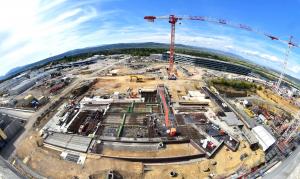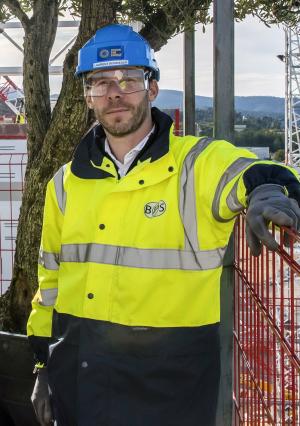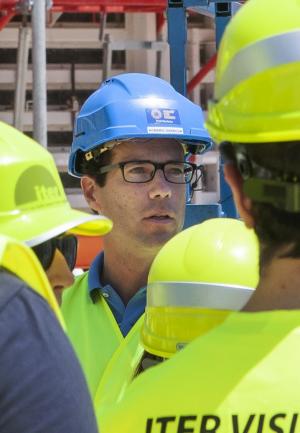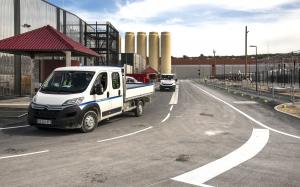"The building works required for First Plasma are 85% complete"
As the European Domestic Agency Program Manager for Buildings, Site Infrastructure and Power Supplies, Laurent Schmieder has been in charge of the construction of the ITER scientific facility since 2009. From a flat and empty stretch of land 13 years ago, the ITER platform today is a crowded and busy place—with 85% of the infrastructure required for First Plasma in place. Newsline caught up with Schmieder and his deputy Romaric Darbour in April just as one of the final paved roads of the platform had been finalized.
Europe, as part of its commitments to the project, is building nearly all of the platform buildings and site infrastructure, which includes 39 buildings and technical areas. Scope includes the civil engineering of buildings; site infrastructure works (drainage and technical galleries), handling items such as cranes, electrical distribution, and site adaptation works such as roads, signage and lighting. The Tokamak Complex (which reunites the Tokamak, Diagnostic and Tritium buildings on a single foundation) has been the largest-term project so far: it took four years to prepare the foundation of this 430,000-tonne structure, and we have been building up since then.
For two years now, the construction of the ITER scientific facility has continued despite COVID-19. In hindsight, what were the biggest challenges of this period and what overall conclusions can be drawn about the effect of the pandemic on ITER construction?
The foundations of the ITER Tokamak Complex were built between 2010 and 2014; since 2014 the Complex structure has been rising. What is the status of the Tokamak Complex today and how close are we to completion?
All structural works for the Tokamak and Diagnostic buildings have been delivered and the secondary works are nearly achieved. Painting is completed at all levels, and we are now in the touch-up phases. Door installation is complete, with only some last fine-tuning to perform. Other small finishing works—such metallic platform installation, concrete plinths, and false floor erection—remain, but by summer 2022 these finishing works will be behind us. It is important to note that Tritium Building construction—which had been on hold since 2017 in order to focus all efforts on the delivery of the Tokamak Building—resumed in 2021 and we expect to have this building completed by mid-2024.
The construction of the installation has proceeded by work package, or "tender batch (TB)." How many tender batches have been completed and how many are in progress or remain to be awarded? What percentage of the work scope has been completed (for buildings and infrastructure required for First Plasma)?
Of 17 tender batches, nine have been completed and eight are ongoing. The building program works required for First Plasma have now reached 85% completion. We are nearing the end of the site infrastructure contract TB16 (service trenches, precipitation drainage, and site adaptation works such as roads and lighting), which has been running since early 2016. In a recent milestone, the team completed the final paved road of the platform. (See image below.)
The F4E team has been assisted from the beginning on site by architect/engineer ENGAGE and worksite safety contractor APAVE. How has the collaboration worked and how do you keep the different elements of the team on the same page?
There is a lot of ITER infrastructure that is not visible to the naked eye—technical galleries, utility networks, drainage tunnels. What can you tell us about this "underground world" that is absolutely critical to ITER operation?
ITER is a bit like an airport: the visible part represents only a small fraction of the works. The underground networks are huge, with more than five kilometres of galleries linking all the buildings and also hundreds of kilometres of networks for the distribution of electricity, water and other fluids. It was a real challenge to manage the construction of all these underground works while at the same time other contractors were building massive structures above ground. Good anticipation and coordination between our teams and contractors was a key factor of success.
We can evaluate that more than 15,000 people have contributed to ITER site construction. Some 5,000 companies, from approximately 10 European countries, have been involved. At the time of this interview, there have been no major accidents and we have not had to report casualties in relation to work on site. The statistics on the worksite (accident frequency rate) are four times better than the French statistics—a big success even if in the area of safety, continuous improvement is essential. We are tracking any "near misses" to improve our processes, to build on lessons learned and to improve our level of safety.
How has the presence of Fusion for Energy staff and contractors evolved over 13 years of construction? How big is the Fusion for Energy team managing the remaining activities and what are your projections for the coming years?
Fusion for Energy activities have change over the time and—while we are at 85% of First Plasma needs—we have reached only 60% of the entire work scope. The BIPS team remains stable (in the range of 80 staff—half from Fusion for Energy and half from the ITER Organization); it will remain mobilized at the same level for the challenges to come. Looking ahead, we have to complete the civil works of the Tritium Building (three more levels to go), finalize a set of buildings necessary for secured power distribution, and complete the ITER Control Building, building services in auxiliary buildings, and technical bridges that will bring electricity and cryogenic fluids into the Tokamak Complex. Another masterpiece will be the ITER Hot Cell facilities, which have a volume and a level of complexity comparable to the Tokamak Complex. So although we have already reached the middle of this long journey, even more challenging activities remain ahead of us!





